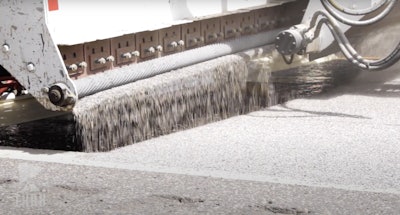Rural Minnesota counties hope the use of a byproduct from the state’s iron ore mining industry could provide a lower-cost way to make dangerous curves safer.
St. Louis County became the first in the state this summer to apply high-friction surface treatment on a county road system, according to the Federal Highway Administration. The anti-slip treatment was applied to 10 curves with a higher risk for vehicles running off the road.
The treatment involves using a high-friction aggregate, mixed with a polymer resin binding. The county is using the standard mixture of calcined bauxite friction aggregate but will also use a byproduct from the state’s taconite mining industry on other sections, according to Crossroads, a blog by the Minnesota Department of Transportation’s Office of Research & Innovation, the University of Minnesota’s Center for Transportation Studies and the Minnesota Local Road Research Board.
 High friction surface treatment being applied in St. Louis County, Minnesota. Credit: Minnesota Local Road Research Board
High friction surface treatment being applied in St. Louis County, Minnesota. Credit: Minnesota Local Road Research Board
Researchers plan to study whether the taconite from the state’s Mesabi Range can fully or partially replace calcined bauxite, which is a higher-cost material.
The comparison study may look at the cost to install and maintain the two types of high-friction surface treatment, as well as their skid resistance, wear over time and effects of snow and ice removal operations.
Taconite has been used for other road repair purposes. It is being studied in Alaska as a way to reduce road wear from studded tires and is being studied in Minnesota as a long-term solution for potholes.










